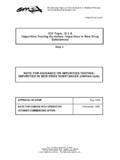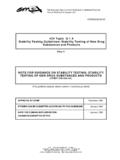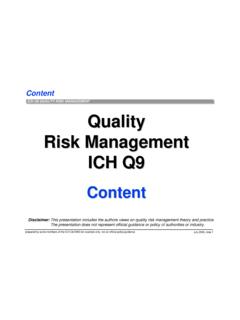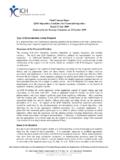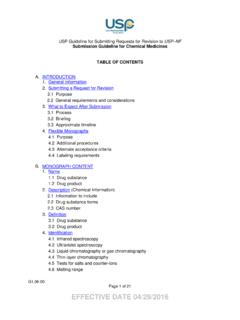Transcription of ICH Topic Q 2 A Validation of Analytical Methods ...
1 The European Agency for the Evaluation of Medicinal ProductsHuman Medicines Evaluation UnitICH - Technical Coordination - R. Bass7 Westferry Circus, Canary Wharf, London E14 4HB, UKTel: (+44-171) 418 84 11 Fax: (+44-171) 418 85 51E_Mail: Topic Q 2 AValidation of Analytical Methods :Definitions and TerminologyStep 5 NOTE FOR GUIDANCE ON VALIDATIONOF Analytical Methods : DEFINITIONS ANDTERMINOLOGY (CPMP/ICH/381/95)APPROVAL BY CPMPN ovember 1994 DATE FOR COMING INTO OPERATION(STUDIES COMMENCING AFTER)1 June 1995 CPMP/ICH/381/951/5 Validation OF Analytical Methods :DEFINITIONS AND TERMINOLOGYICH Harmonised Tripartite Guideline[EMEA Status as of November 1994] document presents a discussion of the characteristics for consideration during thevalidation of the Analytical procedures included as part of registration applications submittedwithin the EC, Japan and USA. This document does not necessarily seek to cover the testingthat may be required for registration in, or export to, other areas of the world.
2 Furthermore,this text presentation serves as a collection of terms, and their definitions, and is not intendedto provide direction on how to accomplish Validation . These terms and definitions are meantto bridge the differences that often exist between various compendia and regulators of the EC,Japan and objective of Validation of an Analytical procedure is to demonstrate that it is suitable forits intended purpose. A tabular summation of the characteristics applicable to identification,control of impurities and assay procedures is included. Other Analytical procedures may beconsidered in future additions to this OF Analytical PROCEDURES TO BE VALIDATEDThe discussion of the Validation of Analytical procedures is directed to the four most commontypes of Analytical procedures: Identification tests. Quantitative tests for impurities ' content. Limit tests for the control of impurities . Quantitative tests of the active moiety in samples of drug substance or drug product orother selected component(s) in the drug there are many other Analytical procedures, such as dissolution testing for drugproducts or particle size determination for drug substance, these have not been addressed inthe initial text on Validation of Analytical procedures.
3 Validation of these additional analyticalprocedures is equally important to those listed herein and may be addressed in brief description of the types of tests considered in this document is provided below. Identification tests are intended to ensure the identity of an analyte in a sample. This isnormally achieved by comparison of a property of the sample ( , spectrum,chromatographic behavior, chemical reactivity, etc) to that of a reference Testing for impurities can be either a quantitative test or a limit test for the impurity in asample. Either test is intended to accurately reflect the purity characteristics of thesample. Different Validation characteristics are required for a quantitative test than for alimit test. Assay procedures are intended to measure the analyte present in a given sample. In thecontext of this document, the assay represents a quantitative measurement of the majorcomponent(s) in the drug substance.
4 For the drug product, similar validationcharacteristics also apply when assaying for the active or other selected component(s).The same Validation characteristics may also apply to assays associated with otheranalytical procedures ( , dissolution).The objective of the Analytical procedure should be clearly understood since this will governthe Validation characteristics which need to be evaluated. Typical Validation characteristicswhich should be considered are listed below:AccuracyPrecisionRepeatabilityInte rmediate PrecisionSpecificityDetection LimitQuantitation LimitLinearityRangeEach of these Validation characteristics is defined in the attached Glossary. The table liststhose Validation characteristics regarded as the most important for the Validation of differenttypes of Analytical procedures. This list should be considered typical for the analyticalprocedures cited but occasional exceptions should be dealt with on a case-by-case basis.
5 Itshould be noted that robustness is not listed in the table but should be considered at anappropriate stage in the development of the Analytical revalidation may be necessary in the following circumstances: changes in the synthesis of the drug substance; changes in the composition of the finished product; changes in the Analytical procedure;The degree of revalidation required depends on the nature of the changes. Certain otherchanges may require Validation as of analyticalprocedureIDENTIFICATIONTESTING FORIMPURITIESASSAY-dissolution(measureme nt only)- +-+Precision Repeatability +-+ (1)-+ + (1)Specificity (2)++++Detection Limit-- (3)+-Quantitation Limit-+--Linearity-+-+Range-+-+-signifie s that this characteristic is not normally evaluated+signifies that this characteristic is normally evaluated(1)in cases where reproducibility (see glossary) has been performed, intermediate precisionis not needed(2) lack of specificity of one Analytical procedure could be compensated by othersupporting Analytical procedure(s)(3)may be needed in some casesCPMP/ICH/381/954 ProcedureThe Analytical procedure refers to the way of performing the analysis.
6 It should describe indetail the steps necessary to perform each Analytical test. This may include but is not limitedto: the sample, the reference standard and the reagents preparations, use of the apparatus,generation of the calibration curve, use of the formulae for the calculation, is the ability to assess unequivocally the analyte in the presence of componentswhich may be expected to be present. Typically these might include impurities , degradants,matrix, of specificity of an individual Analytical procedure may be compensated by othersupporting Analytical procedure(s).This definition has the following implications:Identification:to ensure the identity of an Tests: to ensure that all the Analytical procedures performed allow anaccurate statement of the content of impurities of an analyte, relatedsubstances test, heavy metals, residual solvents content, (content or potency):to provide an exact result which allows an accurate statement on thecontent or potency of the analyte in a accuracy of an Analytical procedure expresses the closeness of agreement between thevalue which is accepted either as a conventional true value or an accepted reference value andthe value is sometimes termed precision of an Analytical procedure expresses the closeness of agreement (degree ofscatter) between a series of measurements obtained from multiple sampling of the samehomogeneous sample under the prescribed conditions.
7 Precision may be considered at threelevels: repeatability, intermediate precision and should be investigated using homogeneous, authentic samples. However, if it is notpossible to obtain a homogeneous sample it may be investigated using artificially preparedsamples or a sample precision of an Analytical procedure is usually expressed as the variance, standarddeviation or coefficient of variation of a series of expresses the precision under the same operating conditions over a shortinterval of time. Repeatability is also termed intra-assay precision . precisionIntermediate precision expresses within-laboratories variations: different days, differentanalysts, different equipment, expresses the precision between laboratories (collaborative studies,usually applied to standardization of methodology). LimitThe detection limit of an individual Analytical procedure is the lowest amount of analyte in asample which can be detected but not necessarily quantitated as an exact LimitThe quantitation limit of an individual Analytical procedure is the lowest amount of analyte ina sample which can be quantitatively determined with suitable precision and accuracy.
8 Thequantitation limit is a parameter of quantitative assays for low levels of compounds in samplematrices, and is used particularly for the determination of impurities and/or linearity of an Analytical procedure is its ability (within a given range) to obtain testresults which are directly proportional to the concentration (amount) of analyte in the range of an Analytical procedure is the interval between the upper and lowerconcentration (amounts) of analyte in the sample (including these concentrations) for which ithas been demonstrated that the Analytical procedure has a suitable level of precision, accuracyand robustness of an Analytical procedure is a measure of its capacity to remain unaffected bysmall, but deliberate variations in method parameters and provides an indication of itsreliability during normal usage.
